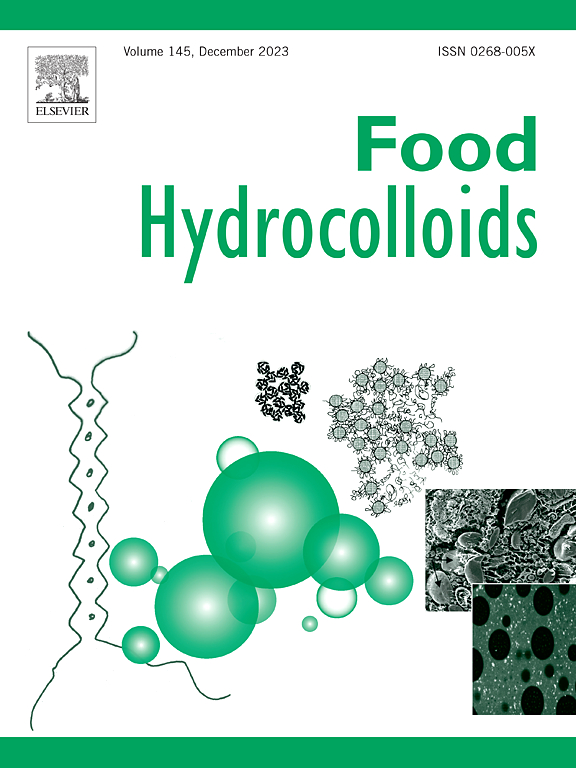Improving the physicochemical properties of microbial transglutaminase-induced fish gelatin gels by incorporating sanxan as a novel way
IF 11
1区 农林科学
Q1 CHEMISTRY, APPLIED
引用次数: 0
Abstract
Fish gelatin (FG) is recognized as a promising alternative to mammalian gelatin sources. However, some undesirable physicochemical properties of FG such as weak texture, poor rheology, and poor thermostability limit its application. This study explored the effect of sanxan (SX) on the FG gelling behavior under conditions induced by microbial transglutaminase (MTGase). It was observed that the water-holding capacity, gel strength, and viscoelastic characteristics of FG gel were enhanced by adding SX. Meanwhile, thermogravimetric analysis exhibited that the thermostability of FG was also improved. Zeta potential measurements suggested the presence of electrostatic interactions between SX and FG. FTIR spectral analysis revealed that the added SX significantly affected the secondary structure of FG and verified the presence of both hydrogen bond and electrostatic interactions between FG and SX. The added SX reduced the α-helix content and increased the β-sheet content, leading to orderly aggregation and protein unfolding. This resulted in the formation of a dense and uniform FG-SX composite gel network. Additionally, intrinsic fluorescence, surface hydrophobicity, and protein solubility analyses revealed that hydrophobic interactions are crucial in the forming the FG-SX composite gel. These findings offer new insights into the potential of SX as a natural and innovative gel modifier to enhance the functionality of enzyme-induced protein gel-based foods.

以三散为原料改善微生物转谷氨酰胺酶诱导的鱼明胶的理化性质
鱼类明胶(FG)被认为是一种有前途的替代哺乳动物明胶来源。但FG的一些理化性质如织构弱、流变性差、热稳定性差等限制了其应用。本研究探讨了在微生物谷氨酰胺转胺酶(mtase)诱导下,三散(SX)对谷氨酰胺凝胶行为的影响。结果表明,SX的加入提高了FG凝胶的持水性、凝胶强度和粘弹性。同时,热重分析表明,FG的热稳定性也得到了改善。Zeta电位测量表明SX和FG之间存在静电相互作用。FTIR光谱分析表明,SX的加入显著影响了FG的二级结构,并验证了FG与SX之间存在氢键和静电相互作用。SX的加入降低了α-螺旋的含量,增加了β-片的含量,导致蛋白质有序聚集和展开。这就形成了致密而均匀的FG-SX复合凝胶网络。此外,固有荧光、表面疏水性和蛋白质溶解度分析表明,疏水相互作用在FG-SX复合凝胶的形成中至关重要。这些发现为SX作为一种天然和创新的凝胶调节剂来增强酶诱导蛋白凝胶食品的功能提供了新的见解。
本文章由计算机程序翻译,如有差异,请以英文原文为准。
求助全文
约1分钟内获得全文
求助全文
来源期刊

Food Hydrocolloids
工程技术-食品科技
CiteScore
19.90
自引率
14.00%
发文量
871
审稿时长
37 days
期刊介绍:
Food Hydrocolloids publishes original and innovative research focused on the characterization, functional properties, and applications of hydrocolloid materials used in food products. These hydrocolloids, defined as polysaccharides and proteins of commercial importance, are added to control aspects such as texture, stability, rheology, and sensory properties. The research's primary emphasis should be on the hydrocolloids themselves, with thorough descriptions of their source, nature, and physicochemical characteristics. Manuscripts are expected to clearly outline specific aims and objectives, include a fundamental discussion of research findings at the molecular level, and address the significance of the results. Studies on hydrocolloids in complex formulations should concentrate on their overall properties and mechanisms of action, while simple formulation development studies may not be considered for publication.
The main areas of interest are:
-Chemical and physicochemical characterisation
Thermal properties including glass transitions and conformational changes-
Rheological properties including viscosity, viscoelastic properties and gelation behaviour-
The influence on organoleptic properties-
Interfacial properties including stabilisation of dispersions, emulsions and foams-
Film forming properties with application to edible films and active packaging-
Encapsulation and controlled release of active compounds-
The influence on health including their role as dietary fibre-
Manipulation of hydrocolloid structure and functionality through chemical, biochemical and physical processes-
New hydrocolloids and hydrocolloid sources of commercial potential.
The Journal also publishes Review articles that provide an overview of the latest developments in topics of specific interest to researchers in this field of activity.
 求助内容:
求助内容: 应助结果提醒方式:
应助结果提醒方式:


